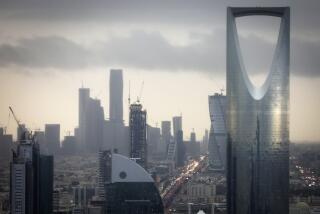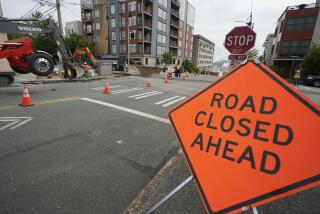THE ASIA BOOM : Public Works : Asians Power Up the Private Sector : Billions are needed to build roads, bridges, airports and utilities--far more than governments can finance on their own.
- Share via
MANILA — Just two years ago, the Philippines suffered crippling electrical brownouts almost daily. Workers sweltered in offices without air conditioning, shops had gasoline generators throbbing on the sidewalks outside, and factories were forced to curtail production because of the shortage of power.
“We were really hurting,” recalled Guido Delgado, head of the state-owned National Power Co. “Not only did we need power fast, we needed to get in place huge amounts of generating capacity.”
Faced with a desperate situation--no new power plants had been built for six years--the Philippines turned to a relatively new concept from the United States: independent, private power companies. A nearly bankrupt government with a disastrous credit rating approached foreign companies and offered them carte blanche if they could get the Philippines powered again.
Now, thanks to the crash program, brownouts are largely an unpleasant memory. More than $1 billion has been spent in the power sector since 1992, and electricity supplies have surged 18% in the past year.
Long regarded as one of the most backward countries in Asia, the Philippines has blazed a trail of privatized infrastructure projects that is being followed by governments from New Delhi to Beijing.
The reasons are obvious: Asia is in the midst of a boom of historic proportions. According to estimates by the Asian Development Bank, Asian countries, not including Japan, will have to spend $1.3 trillion in the coming decade on power, roads and other infrastructure just to keep up with their burgeoning economies. And Japan will spend $6.3 trillion on a host of public works projects of its own.
The Asian skyline is filled with construction cranes, from dams in India to magnetically levitated trains in Japan. The building of Hong Kong’s new airport and its access roads and bridges, with a total cost of $20 billion, is one of the most expensive construction projects ever contemplated.
“Infrastructure development is indispensable in a country’s overall economic development,” said Cordell Hull, chairman of Bechtel Enterprises Inc., a giant California construction firm. “If it lags, there will be bottlenecks, inefficiencies and delayed or impeded economic development.”
In China, for example, after more than a decade with yearly 10% growth, infrastructure needs are huge. The average time between trains is only about eight minutes, an indication that the tracks are dangerously overcrowded. Most ports are working at full capacity, and electrical brownouts are common.
Chinese officials estimate that the country will need 17,000 megawatts of new power production every year until the end of the decade. By comparison, the largest electric utility in North America, Ontario Hydro, has 34,000 megawatts.
“China’s infrastructure hasn’t kept up with economic growth,” said Gerald L. Murdock, president of Hong Kong-based Asia Power Group Inc. “The country’s power-generating capacity was inadequate to start with. The miles of China’s railroads are the same now as at the time of the civil war in 1947.”
Even a country as backward as Vietnam, which has virtually no modern industry to speak of, is forecasting that it will have to spend $500 million a year to meet its electricity needs.
Economists have found a direct link between investment in infrastructure and a country’s wealth. A World Bank study concluded that, for every 1% increase in a country’s economic growth, power supplies increased by 1.5%, telecommunications by 1.7% and paved roads by 0.8%. Since Asia’s economic growth has averaged 8% for the past decade, all the infrastructure needs have risen accordingly.
As recently as a decade ago, most governments in Asia relied on public borrowing to finance their infrastructure projects and operated them as state-owned monopolies. But Asian governments found they do not have the cash to meet the huge financing costs expected in the next decade, and they have had to tap the private sector. Besides, private companies tend to do the job faster and more efficiently.
“The capital requirements are beyond the reach of most governments,” said Vladimir Bohun, who heads the power division of the Manila-based Asian Development Bank. “We estimate that the region needs $500 billion over the next decade for the power sector alone.”
As in the Philippines, many of the developing private projects are “build-operate-transfer” enterprises. A private company is given a government contract to build an electric power plant, for example, operates the plant for 20 years at an agreed price for electrical power, then turns it over to the government at no charge. The country gets the electricity with little investment of public money, while the company reaps the benefit of high returns on investment.
So far, privatized infrastructure projects have been used mainly for power plants. But the concept was also employed to build highways in Malaysia, Thailand and China, as well as telephone systems and ports.
One piece of good news for the United States in all this construction is that U.S. companies are well-positioned to profit. In Bangkok, for example, a joint venture between Nynex Inc., one of the Baby Bells, and a Thai conglomerate has been signed up to install 2 million telephone lines using equipment provided by AT&T.; In the past year, the company’s investment has tripled in value to $1.2 billion.
Donald M. Kusza, the head of General Electric’s power systems division in the Southeast Asia region, said the company has signed up $1.6 billion in new business so far this year, compared to $900 million for all of last year. Asia accounts for a 35% share of the company’s business, almost the same as the U.S. market.
“The growth now is in the Asian market,” Kusza said. “The opportunity for growth out here is great. U.S. products are well received, we have the best technology, and the Japanese up to now have not been aggressive players.”
While companies such as General Electric and Bechtel have been participants in the Asian infrastructure market for decades, the recent push toward privatization has seen some relatively new players.
One of the biggest is Mission Energy Co., a subsidiary of Southern California Edison. Mission recently took a 32.5% share of a joint venture with General Electric and Mitsui Co. of Japan, building a vast coal-fired power complex in Indonesia.
Enron Corp., a Houston-based oil and gas conglomerate, set up two power plants in the Philippines and was the first foreign company to get the go-ahead for a private power plant in India.
For those who arrived as pioneers in the market, returns on their investment has been handsome. Companies setting up power stations in the Philippines two years ago are realizing up to 25% returns on equity, while India has guaranteed a minimum profit of 16% a year.
“You can’t repossess a power station or a highway if the deal goes bad, so these companies have to be compensated for their risks,” said one international banker. “If I could, I’d put all my money in one of these power projects. They are paying an unbelievable return.”
In addition to new companies arriving to help shape what is being hailed as the “Pacific Century,” Western firms are also looking to the region to help finance the huge new projects.
A recent arrival is the Asian Infrastructure Fund, which was created by international investor George Soros and Peregrine Securities, a Hong Kong firm, to invest directly in infrastructure projects. Will Lilley, the fund’s managing director, said the fund has so far raised about $530 million out of an expected $1.6 billion.
“Huge sums of money are at stake in Asia,” Lilley said. “The state sectors have basically failed, and they need private capital money to meet their people’s needs for power, water, telephones and roads. There could be a worldwide shortage of capital.”
Another source of money is the domestic market in Asian countries, which have witnessed the growth of a relatively large middle class in the past decade. OSK & Partners, a stockbroker in Kuala Lumpur, Malaysia, estimates that, of the $14.7 billion earmarked for infrastructure projects in the next five years, $3 billion will be provided by domestic investors.
Richard McIndoe, a banker with the British merchant bank S.G. Warburg, noted in an interview that big Western banks are proving hesitant to get involved in the rush to finance infrastructure projects. Banks tend to have shorter horizons than the 25 years required by such deals. They also are worried that, if a developer finances a project in China in dollars, the Beijing government might later devalue the currency. As a result, only a handful of banks have become involved.
The Asian infrastructure industry suffered through a nightmare of sorts in Thailand last year when a Japanese company finished construction of a toll road through the center of Bangkok. The Thai government waited until the project was completed to announce that the proposed toll was too high, and it seized control of the road. Eventually, a buyout was arranged, but the incident has made investors throughout the region jittery.
“High rewards mean high risks, and the latter exist in abundance in Asia,” said Robert C. Broadfoot, managing director of Political & Economic Risk Consultancy Ltd., a Hong Kong firm that measures risks for its corporate clients. “While we believe that more money will be made in infrastructure in Asia in the coming decade than perhaps anywhere else in the world, we also fear that more money will be lost.”
Projected Asian Infrastructure Spending 1994-2000
Asian countries, not including Japan, are poised to spend about $1 trillion in the next few years on transportation, power and other infrastructure projects. China is expected to claim the lion’s share.
* The Projects (%)
Transportation: 35
Power: 35
Telecommunications: 15
Utilities: 10
Other: 5
* The Nations (%)
China: 34
India: 23
Indonesia: 9
South Korea: 9
Thailand, Malaysia, Taiwan: 15
Other: 10
SOURCE: Political & Economic Risk Consultancy Ltd. in Hong Kong
More to Read
Sign up for Essential California
The most important California stories and recommendations in your inbox every morning.
You may occasionally receive promotional content from the Los Angeles Times.













